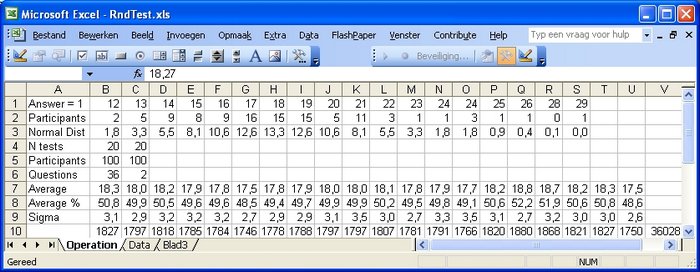Each experiment comprised 100 sessions of 36 trials per session in which the same PRNG or RNG provided both the left/right response of a virtual participant and the subsequent left/right position of the target. These control experiments all yielded null results: The hit rates were 49.5% , 50.4%, and 49.5% respectively.
 Test 1: 100 participants and 36 trials using neutral pictures.
Test 1: 100 participants and 36 trials using neutral pictures. |
- The top line shows the number of 1 or true or yes answers of one participant.
- Line 2 shows the number of partipants that gave that answer in the last session. In this case session 20.
i.e. 2 partipants answered 12 times with 1. 13 participants answered 5 times with 1. 18 partipants answered 15 times with 1. (This is the expected average number) etc. - Line 3 shows the normal distribution in case the average number of 1 answers 18 is.
- Line 4 shows the number of sessions N. Cell 3 shows the active session in progress. Because all the sessions are finished the current value is 20.
- Line 5 shows the number of participants. Cell 3 shows the current participant simulated. Because all the sessions are finished the current value is 100.
- Line 6 shows the number of questions asked. Cell 3 shows the number of answers possible. In this case because it is a true/false simulation this value is 2.
- Line 7 shows the average number of 1 answers for all 20 sessions.
- Line 8 shows the average number of 1 answers in % for all 20 sessions. The minimum number is 48.5% and the maximum number is 52.2%. The 3 hit rates of 49.%, 40.4% and 49.5% are clearly within that range.
- Line 9 shows the sigma or variance values for each of the 20 sessions.
- Line 10 shows the total number of all the 20 sessions. Cell 22 shows the total of all those totals. The value 36028 is very close what is expected i.e 36 * 100 * 20 / 2 = 36000.